Ecuador Bird Watching Trip Report
Dec. 28, 2006 - Jan 7, 2007
Marilyn and Dave Binkley
Lakewood, CO USA
The pre-birding days, Dec 28 through Jan 2
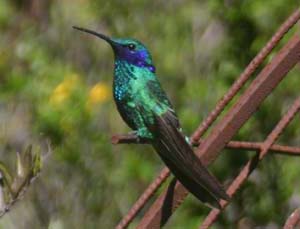 |
 |
One advantage of choosing Hosteria San Jorge for our birding is that many other tours and activities are offered as well as having the lodging, meals, box lunches and transportation all handled by the Hosteria. For guided activities with Marilyn’s daughters we choose a day each of; mainly downhill mountain biking, a trip to Papallacta Hot Springs, and a tour to the market at Otavalo. We had 2 days left to our own devices at the Hosteria and we birded some on our own as well as hiking above the lodge for the view as well as hiking to a waterfall. Of course these activities turned up a few birds that we were able to identify. Sparkling Violetears, Shining Sunbeams and White-bellied Woodstars were common at the Hosteria feeders and we had several good looks at Black-tailed Trainbearers around the grounds. The other bird of note was a Southern Yellow Grosbeak on the grounds.
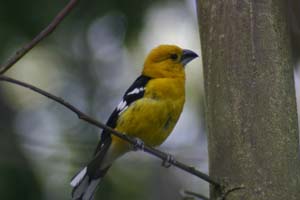 |
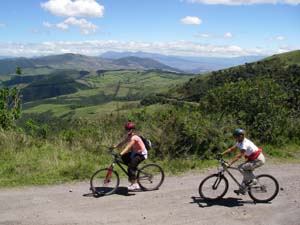 |
Guided birding Day 1, January 3, 2007
 |
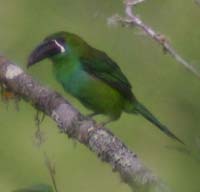 |
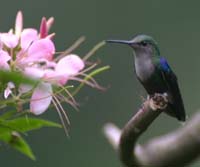 |
We were birding by 6:15 a.m. from the dirt road along the Tandayapa Valley northeast of Quito. As expected the bird activity was heavy, causing the confusion as per field marks as guides and birders sometimes had different birds in their binoculars. We walked slowly up the road seeing one colorful tanager after another as well as a couple of woodpeckers. At one point, we seemed to be “herding” a Squirrel Cuckoo up the road in front of us. This allowed us several looks at this large and beautiful bird.
In the afternoon we entered the San Jorge Tandayapa Reserve, walking up to the shelter. This shelter area has quite the amenities for Cloud forest birding. A large picnic table is located under the metal-roofed shelter. It is there we were provided our sack lunch brought for the day. The shelter itself is perched high on a hillside with just enough taller vegetation “tamed” to allow a nice view of the canopy. At the borders of the shelter were three very, very busy hummingbird feeders. Adding to the birder’s amenities were a small rest room complete with flush toilet and hammocks for the weary birders. Only Cybele allowed herself a short nap as the afternoon birding was just too stunning.
We first concentrated on hummingbirds as they were right in our face. My thrill was finding these hummers awaiting feeding turns so as to allow photos without the usual red plastic present. Although not rare, we were fascinated by this, our first look at the Booted Racket-tail. The shortest visit was by the Purple-bibbed Whitetip.
After an hour and a half dominated by “lunch with the hummers”, we turned our attention to the seemingly continuous parade of birds traveling along the canopy. We saw many of the same tanagers as in the morning, but now we could see their backs instead of their bellies. During this time we had a Crimson-rumped Toucanet hang around for over an hour. During the rare lulls in the tanager and other smaller bird traffic, we checked in on the feeding progress of this Toucanet. According to our guides, the rare bird find of the day was a pair of White-throated Quail-Doves. We all had great looks at these long-legged birds as they walked up a large tree to the chosen roosting/feeding location. We, including the novice couple Cybele and Chad, were reluctant to call an end to the afternoon at San Jorge Tandayapa Reserve.
Guided Birding day 2, January 4, 2007
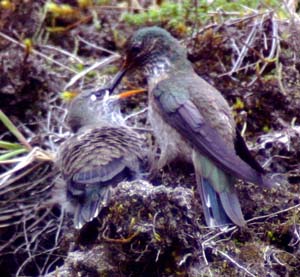 |
 |
We started the day’s birding on the High Barren Plain at 4000 meters just off a pass southeast of Quito. It was blustery, but we found seedeaters, and surprisingly three different hummingbird species. The several minutes spent watching an Ecuadorian Hillstar make trip after trip to feed her baby made us forget the cold ears and hands.
The breakfast and later morning were spent along a dirt road approaching Papallacta Lake at about 3500 meters. I noticed some movement low in the bushes and had a quick look at a Tawny Antpitta. The lake had Yellow-billed Pintail, Andean Teal and Andean Gulls. We enjoyed helping our guides identify a Greater Yellowlegs, a life-bird for both Jorges.
Lunch and the afternoon birding were at a farm owned by friends of Jorge at 2000 meters in the Amazon Basin. We oohed and ahhed over the Long-tailed Sylph and had our first quetzal, the Crested Quetzal. Other birds we enjoyed for long looks were the Cinnamon Flycatcher and the Collared Inca.
We had almost made it back to the car in the approaching twilight when we had a late double sighting. We were able to follow a family of Torrent Ducks as they swam from rock to rock for several minutes. After enjoying this show for a while, Marilyn realized that the target White-capped Dipper was in the background.
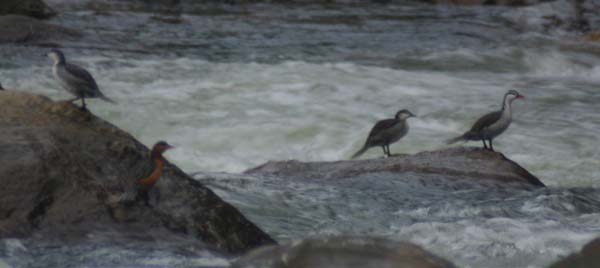
Guided Birding Day 3, January 5, 2007
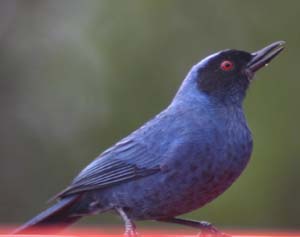 |
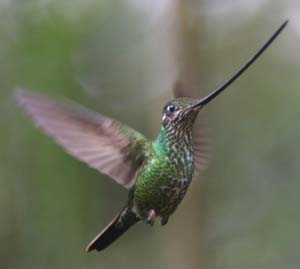 |
We began the day birding the grounds at Hosteria San Jorge, guided by Jorge Jr. We hiked all the way to the waterfall that we had found on our own a few days previous. We saw several birds, about half of them new for the trip. The best looks included the Hooded Siskin and the Spectacled Whitestart. The Siskin was nice enough to perch bush-top for a couple minutes; the Whitestart game us a similar amount of time of frantic gleaning.
After a late and large breakfast/brunch at the Hosteria dining room, we headed for Yanacocha Reserve. This reserve is run by a foundation and is Cloud Forest on a very steep slope. We definitely had the clouds this day! We were walking the 2½ km into the main feeder station during a less active time of day, but our hiking was rewarded by both the Bar-bellied and Powerful Woodpeckers.
At the main feeder station, we just sat on benches in the middle of hummingbird chaos. I again used the hummingbird feeder waiting as an opportunity for many pictures without the feeders in the frames. Our favorites here were the Sword-billed Hummingbird and the Great Sapphirewing. Besides many other new hummers, the feeders attracted Black, Glossy and Masked Flowerpiercers for close looks. Again, we were reluctant to leave the colorful display at the feeders, but other birds called to be observed.
On the hike out, Jorge asked about how we wanted to use the few remaining hours of light. After some discussion, we decided to make finding an Andean Cock-of-the-Rock a priority. For this we returned to the Tandayapa Valley area, this time above the Tandayapa Reserve. We heard the strange screeching of these odd birds several times from the moving car, but they were deep in the canyon and we just couldn’t steal a look after stopping. A little lower we walked and birded along the road in an area known to often have at least one pair of these birds. It didn’t happen quickly, and we didn’t have a long look, but finally patience and following the squawking rewarded us with a totally open view as a male decided to fly up at least 50 feet toward the canopy.
Guided Birding day 4, January 6, 2007
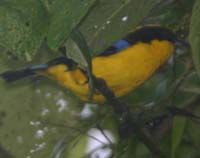 |
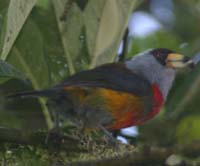 |
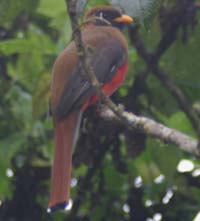 |
On this day we headed west of the Hosteria toward Milpe. Our first stop was before sunup at a highway intersection. The bushes and trees there, near some billboards, and just a few feet off the road were just teeming with colorful “early birds”. Within minutes of stopping we had a Masked Trogon pair, two Toucan Barbets, and a group of Blue-winged Tanagers just out of arm’s reach. Not as close, but still nearby was a pair of Golden-headed Quetzals. Seemingly countless other birds entertained us for nearly an hour. This stop had the most concentrated birds of our tour-with the exception of the hummingbird feeder stations.
Our next stop was at a house with yet another busy sugar-water feeding station. Here we had continual looks at the Velvet-purple Coronet and the Violet-tailed Sylph as well as our old friend the Booted Racket-tail.
 |
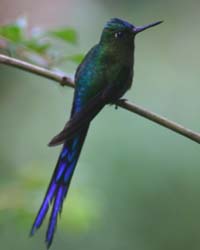 |
 |
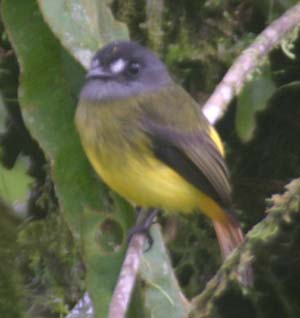 |
 |
After breakfast we headed down the road to Jorge’s Milpe Lodge. A bit about the lodge: This modern lodge is well situated on the steep side of a canyon complete with a noisy rushing river. As at Tandayapa, the rainforest in front of the deck is tamed just enough to allow a good view of several large treetops and a partial view down into the canyon. The lodge elevation is 900 meters, the lowest we had birded in Ecuador. The dining is in an outdoor shelter with the usual hummingbird feeders to help divert one from appreciating the healthy and very good food. This lodge is new and we were just the 3rd guests to appreciate this reserve with the luxury of staying right on site.
Back to the getting to the Milpe lodge; we progressed very slowly, as we birded this dirt road for the entire 2-mile length. Again the tanagers were numerous as well as the Flycatchers. My favorite in this last category was the diminutive Ornate Flycatcher. To compliment the color show we had Smooth-billed Anis just off the road.
Once settled in the Milpe Lodge, we ate lunch and followed that with a siesta. Our siesta was interrupted by Jorge Jr. He had spotted a rare Crimson-bellied Woodpecker just in front of the lodge deck. I got a look at this large woodpecker, but unfortunately, Marilyn arose just seconds too late. After our naps we did the more difficult birding by walking the trails of the reserve. We ended the walk around 6 p.m. on a grassy knoll. This allowed a better view and we ended the day’s birding with two toucans. Both the Pale-mandibled Aracari and the Choco Toucan flew into view and then perched for better looks. Even without the Crimson-bellied Woodpecker, Marilyn tallied 94 species today!

Guided Birding day 5, January 7, 2007
 |
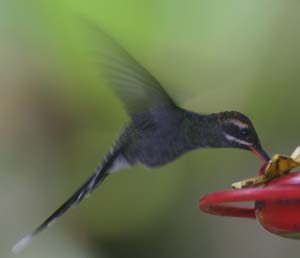 |
Our final day of birding started with nearly two hours of identifying birds from the lodge deck. Again, many tanagers were present including the White-winged Tanager. A Purple Honeycreeper gave us a long look, but the showiest bird of the early morning was the Broad-billed Motmot.
After breakfast with the White-whiskered Hermits and the Green-crowned Woodnymphs, we again set out on the preserve trails. Highlights during this walk were a nice look at a female Andean Cock-of-the-Rock and also a look at the absurdly long, bright orange legs of the Plumbeous Hawk. We also saw our first antbirds; the Immaculate Antbird and the Bicolored Antbird. This experience taught us an important axiom; “Where there are antbirds, there are surely many ants”. We learned this as we brushed, danced and stomped ourselves free of the pesky critters. After lunch and a nap, we reluctantly left Milpe, ants and all!

Marilyn and Dave Binkley
Lakewood, CO USA
www.mytripjournal.com/BinkleyPeruEcuador2006
Click here for Marilyn’s bird list. “Heard only” birds were numerous, but not listed. Dave did have two birds which Marilyn did not see; the Crimson-bellied Woodpecker (Campephilus haematogaster) and the Tawny Antpitta (Grallaria quitensis).